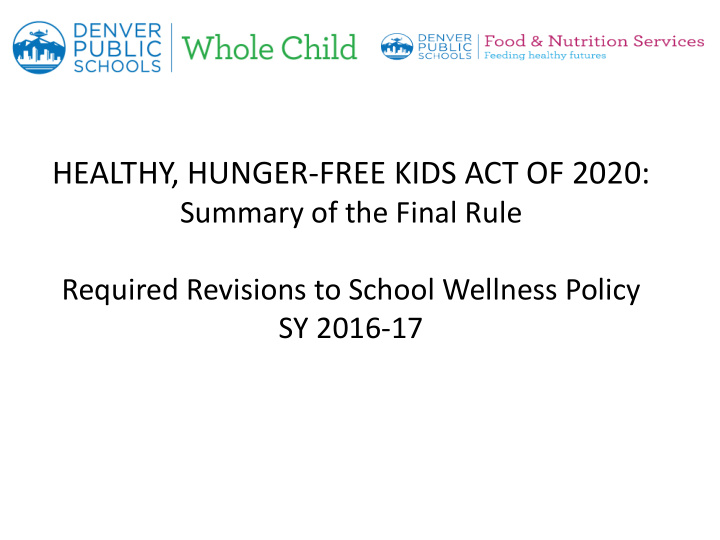



HEALTHY, HUNGER-FREE KIDS ACT OF 2020: Summary of the Final Rule Required Revisions to School Wellness Policy SY 2016-17
Support for the Whole Child In DPS, we are committed to providing equitable and inclusive environments where we ensure students are
Intent of the Policy… Expand the Healthy Hunger-Free Kids Act to strengthen health & • wellness policies and increase transparency. Establish district official(s) to ensure school compliance with the • district wellness. Conduct an assessment of the wellness policy at least every 3 • years. Permit public participation in the wellness policy process. • Establish the district standard for food available and food sold to • students on school property during the school day which includes the food & beverages marketed to students.
So what does this mean for DPS? New rules around foods available to students outside of school • meals: The school wellness policy must include standards for foods and beverages made available on the school campus during the school day including during celebrations, parties, and more. New guidance for marketing of foods at school: The final rule • clarifies that any foods and beverages marketed and sold to students in school must meet Smart Snacks Nutrition standards. If you can’t sell it, you can’t market it!
What is Central Office Required To Do? Policy Update Policy ADF by June 30, 2017, to include the following: (TBD) • • Adopt standards and nutrition guidelines for all foods and beverages sold to students on the school campus during the school day. Must meet USDA guidelines. Adopt standards for all foods and beverages provided, but not sold to students • during the school day e.g. classroom parties, classroom snacks, foods given as incentives. Can be set by DPS. Adopt policies for food and beverage marketing. Must meet USDA guidelines. • Approve the Whole Child, Healthy Child Agenda 2020 as ADF-P to meet the • requirement that establishes specific goals for nutrition, physical activity, and student wellness. (TBD) Conduct an assessment of the district wellness policy every 3 years, at a ü minimum. The assessment must include the following: (Health Advisory Council) Compliance with the wellness policy; and • Progress made in attaining the goals of the wellness policy; and • How the wellness policy compares to model wellness policies. • ü Establish wellness policy leadership to oversee district compliance with the policy. (Health Advisory Council)
What are Schools Required to Do? Practice Adopt school practices that include the goals and • standards set in the district wellness policy Adopt school practices for all foods and beverages • provided, but not sold to students during the school day e.g. classroom parties, classroom snacks, foods given as incentives. Adopt school practices for food and beverage • marketing.
Opportunities and Challenges Opportunity to align school wellness policy • ADF with WCHC Agenda 2020. Opportunity to bring greater focus to the • Whole Child goal in the Denver Plan. Opportunity to promote student health, well- • being and learning. Culture shift regarding food available to • students outside of school meals will affect parents and school staff.
Questions? How big a shift in school practices will the new policy changes • be? Who is best accountable, at the school level, to ensure that • school practice is in alignment with district policy? e.g. discipline policy and school practices What questions do you anticipate from staff and parents? • Should we have ONE set of guidelines for ALL food in schools, • e.g. Smart Snacks and Colorado Healthy Beverage or two? What resources/tool kit will be useful for schools to share with • staff and parents? What training would be helpful? • Other? •
Recommend
More recommend